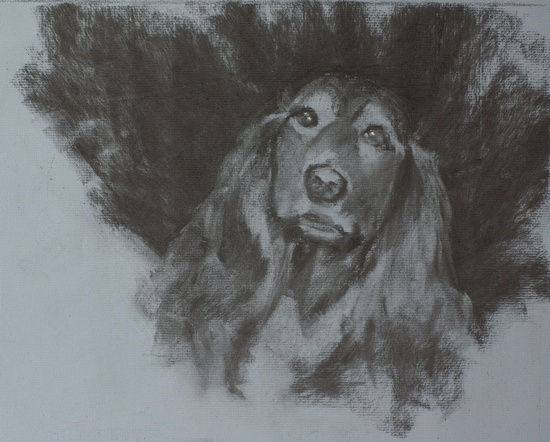Study for Tootsie. 11x14, charcoal on paper. 2017
The artist Barbara Jaenicke recently authored an article where she explained that studies are really explorations of a painting idea. They are a way to distill an almost infinite range of possibilities down to a small number of choices, leaving you with a better understanding of what can be accomplished. In short, they are a way to try something out before you mess up on an expensive canvas.
In this article, I want to expand on Barbara's explanation and offer some additional reasons why it's important to put a little effort into a preliminary study, especially when you work on a portrait.
1. Efficiency
When I start a portrait, I want to make sure I use my time effectively, and it's helpful to know how I'm going to design a painting before I start it. I think it's well worth spending 30 minutes of my time creating a value study if there's even a small chance it will save me days of wasted effort.
I don't want to bash intuitive painting—after all, I often jump in without a fully-realized plan—but it's a risky way to work.
2. Big Picture
A study lets me see the work as a whole right from the start and helps me to think about the painting not as a portrait of a dog (or a landscape, or whatever the subject happens to be), but as an abstract shape within the borders of the canvas.
If I skip this step my mind-set usually focuses on the subject rather than the larger picture, and many of my painting decisions end up not taking the whole into account. It was particularly important in the example above because I nearly ended up with a dog's head floating around freely on the canvas; working on this study showed me that this would be a problem almost immediately.
3. Layout and Positioning
It's too easy to start a portrait with the head too close to the edge of the canvas. Because I start a study with a series of gestural strokes and the big shape outlines, I'm more easily able to correct for it. With the head position established in a study it's easier to start the portrait in the right place, no matter what block-in method is used.
4. Focus on the Big Things
Charcoal is a clumsy medium which naturally takes your attention away from the features and places it on the big forms and shapes. That also happens to be a terrific way to approach the design. And once you start to "paint" rather than "draw" with charcoal it becomes even more useful.
When I started out, I wasn't particularly good with charcoal—I tried to use it like a pencil and often failed to produce anything worthwhile. With more experience, I've come to appreciate just how useful and versatile it can be.
